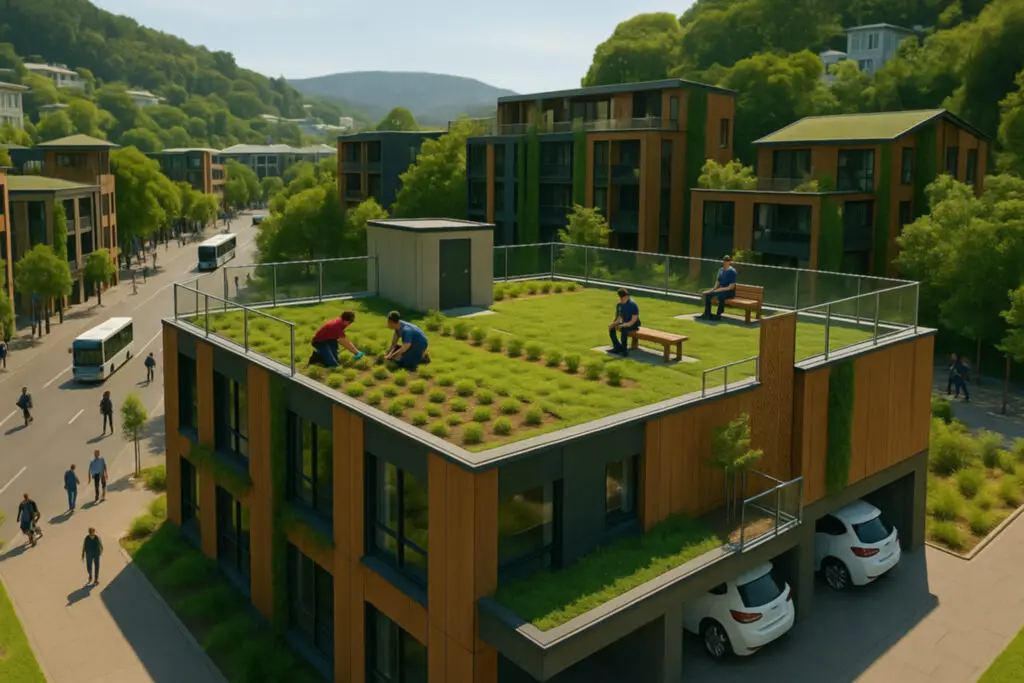Living Rooftops Gardens QandA

What distinguishes extensive and intensive Green living Rooftops Gardens?
Green living Rooftops Gardens fall into two main categories that differ in soil depth, weight, and intended use. Extensive roofs use less than 150 mm of lightweight engineered substrate and hardy, low-growing plants. Designers choose them when low maintenance and ecological services matter more than human access. Intensive roofs exceed 150 mm of soil, support shrubs or small trees, and often include paths for visitors. These park-like roofs weigh more and need irrigation and regular gardening, so engineers must verify structural capacity. Some projects adopt semi-intensive blends to balance access and load. Regardless of type, every living roof contains waterproofing, drainage, a root barrier, substrate, and vegetation that protects the building below while creating habitat above.
How do Green living Rooftops Gardens manage heat and storm-water?
Green living Rooftops Gardens give cities a natural cooling and drainage system in one layer. Soil and plants absorb rainfall, slowing runoff and reducing flood peaks; a University of Queensland trial found a 100 mm roof cut runoff by about 42 percent. Evapotranspiration and shading keep surfaces cooler. Sydney researchers measured vegetated roofs up to 20 °C cooler than bare roofs on the same summer day. Lower surface temperatures translate into cooler indoor spaces and smaller air-conditioning loads. By buffering rain and heat, living roofs protect infrastructure, enhance comfort, and build climate resilience. Planners now treat rooftop vegetation as essential “sponge city” infrastructure. City of Sydney field data confirms these effects.
What recent innovations improve Green living Rooftops Gardens?
Recent innovations are making Green living Rooftops Gardens lighter, smarter, and easier to install. Engineered substrates combine recycled aggregates, expanded clay, and bio-char, keeping extensive roofs between 80 and 120 kg m² while storing water and nutrients. Pre-vegetated modular trays click into place, reducing labour and disruption; Melbourne’s 1 Treasury Place is comparing modular and traditional methods. Smart irrigation uses soil sensors and weather forecasts to trigger watering only when needed, while dashboards display real-time performance data. Bio solar designs place photovoltaic panels above vegetation; a Barangaroo case study showed a 3.6 percent output gain over eight months (City of Sydney 2024).
What do Green living Rooftops Gardens cost, and how do they pay back?
Green living Rooftops Gardens in extensive form cost about AUD/NZD 150–500 m² to install. Intensive designs range 400–900 m² because they need deeper soils, access paths, and irrigation. Figures include waterproofing, drainage, substrate, vegetation, and labour. Owners should budget 2–5 percent of capital cost annually for inspections, weeding, and equipment upkeep. Vegetation shields the membrane from ultraviolet light and thermal stress, often doubling roof life. Cooling and insulation can cut top-floor HVAC energy use by 10–30 percent. Councils may offer storm-water fee reductions, and higher Green Star ratings attract tenants sooner and at premium rents. When energy savings, deferred replacement, and amenity value are combined, commercial payback periods become acceptable. Industry cost data supports these estimates.
How are designs adapted to different Australian and New Zealand climates?
Australia and New Zealand’s diverse climates guide rather than limit living roof design. Hot inland or northern zones use drought-tolerant natives and sometimes drip irrigation. Trials in Melbourne and Adelaide show Lomandra and Carpobrotus survive heat with little water. Windy Wellington roofs employ low-profile species and perimeter screens to stop soil loss. The Auckland Central City Library roof features mānuka and flax selected with Ngāti Whātua Ōrākei; the planting has thrived through storms and sun. Alpine roofs in Queenstown use insulated assemblies and hardy groundcovers that withstand frost and snow. Careful plant selection, adequate substrate depth, and local expertise let green roofs flourish from tropical coasts to cool highlands.
Which policies and incentives support adoption?
Policy support is growing. Melbourne’s Green Our City plan funds demonstrations, maintains a public register, and supplies technical guides, helping retrofit the Old Treasury Building in 2024. Sydney embeds green roofs in its development control plan and offers innovation grants plus free owner workshops. Auckland Council showcases its 1,800 m² library roof and is exploring rate rebates. Green Star and NABERS tools award points for rooftop vegetation, nudging developers toward adoption. Experts expect stronger measures by 2027, such as density bonuses. Mandatory living roofs on large buildings may follow, because cities seek cooling and flood resilience.
Can living roofs combine solar panels, rainwater harvesting, and edible gardens?
Modern living roofs often integrate multiple sustainable functions. Bio solar configurations place solar panels above vegetation; plants cool panels and raise output, as shown by a 3.6 percent gain in Barangaroo. Blue-green systems add storage layers that capture rainfall for irrigation or toilet flushing. Intensive roofs may dedicate sections to herbs, vegetables, or native bush foods, creating productive roof farms. These multi functional approaches require structural checks and deeper substrates. They maximize every square meter, delivering energy, water retention, habitat, and food together. Case evidence supports the synergy.